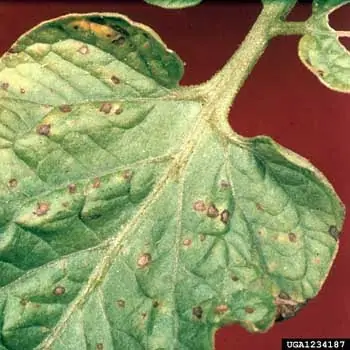Tomato leaf problems appear in different stages of plant growth. It may happen for various reasons, like environmental effects, lack of tomato care, and pathogenic attacks.
The leaf problems are also a symptom or side effect of some diseases. So, continue reading to know the most common leaf problems of tomatoes and the possible solutions.
01: Gray Leaf Spot
Gray leaf spot of tomato is a fungal disease that mostly affects the southern states of the United States. It affects the leaves primarily. Stemphylium Solani, Stemphylium Floridanum, and Stemphylium Botryosum fungus are the main reason for to outbreak of this disease.
Causes and Symptoms:
They can attack tomato leaves at any stage of their life, and leaves die and fall consistently. As a result, sunscald appears on fruits, affecting the plants’ health and reducing production.
You can find yellow halo on leaves, which contain black specks circling brown spots. They create holes, and ultimately the leaves drop.
The fungus can survive easily on garden plant debris, including tomatoes and other species of nightshade plants like peppers, eggplants, and potatoes. They spread out through rain and wind as well as when finding warm or wet weather and due to overhead watering.
Treatments and controls:
Disease-resistant code: “St”
- Prevention is the easiest way to protect gray leaf spots. So always keep on checking your tomato plants.
- You can use early-season fungicides to treat gray leaf spots and other fungal diseases.
- Keep your garden weed free and clear the plant debris.
- Sanitize your garden tools regularly and wash your hands properly.
- Crop rotation can reduce the chance of spreading out this disease but remember, don’t pick similar species of plants as an alternate crop like peppers, eggplants, or potatoes.
- Find some diseases resistant tomato varieties in your respective planting zone.
- Confirm enough sunlight for the tomato plants and extra space between the two plants for aeration.
- Ensure a proper drainage system and keep the plant leaves dry.
- Immediately destroy the affected tomato plants and dig a deep hole to dump and cover the plant debris at the end of the season.
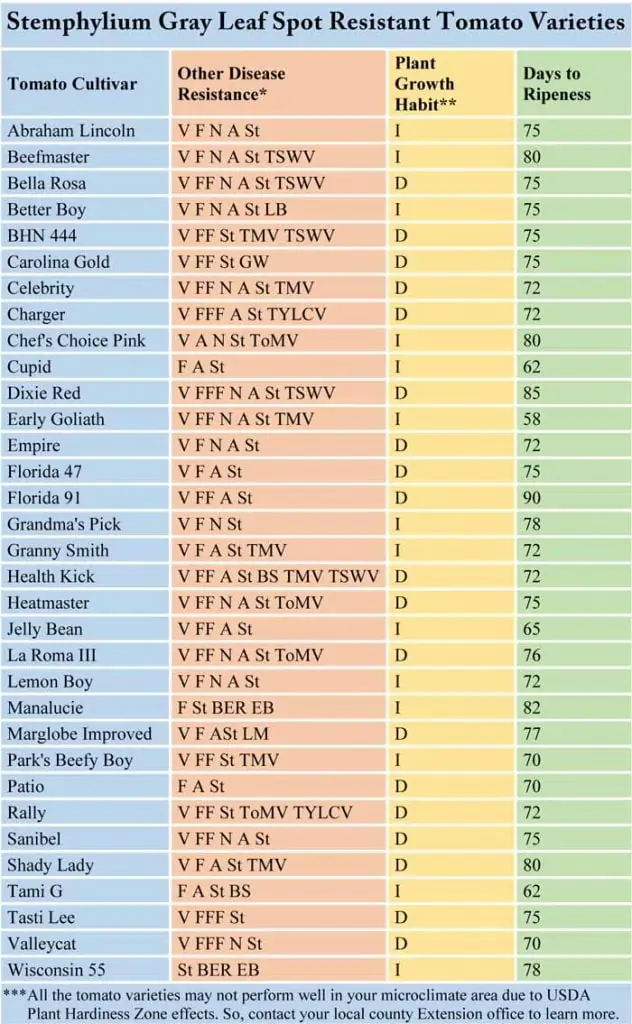
02: Septoria Leaf Spot
Septoria leaf spot of tomato is a devastating fungal disease that mainly attacks the plant leaves due to a fungus called Septoria Lycopersici. It attacks the older leaves at first from the bottom of plants, then gradually jump to newer leaves upwards but rarely harms the fruits.
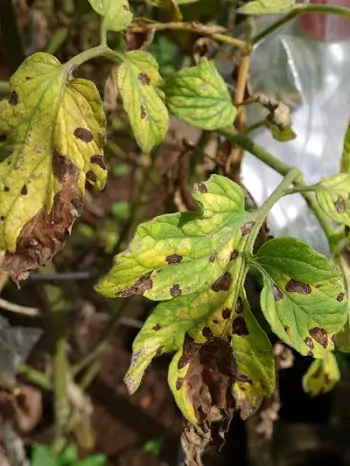
Causes and symptoms:
Septoria leaf spots are scattered when getting wet and humid weather for a longer period. They can travel by wind and rain and outbreak in temperatures of 60°-80° Fahrenheit.
In the first stage, some water-soaked small spots appear on the undersides of leaves.
In the second stage, spots grow, mature, become bigger, and coalesce.
In the final stage, the spots turned into a dark brown pimple-like structure in the center.
Extremely infected leaves fall off and weaken the plants.
Treatments and controls:
Disease-resistant code: “S” or “SLS”
- Remove the infected leaves and destruct to reduce the risk of the disease.
- Dispose of the garden plants’ debris (leaves and stems of nightshade family plants) by dumping or burning.
- Use a fungicidal sprayer to protect the disease from growing further and attacking new leaves.
- Using crop rotation is a wise way to skip this fungal problem. Keep away from tomato cultivation at least two years or change the location.
- Hygiene gardening tools after working in the field.
- Regular mulching and staking of plants for proper air circulation to reduce the chance of flourishing the disease.
- Find some disease-resistant tomato varieties.
- Using a raised bed for a proper drainage system to avoid Septoria leaf spots.

03: Leaf rolling or curling
Tomato leaf curling and rolling are common matters for tomato gardeners. This may occur for physiological conditions, a side effect of herbicides, or a viral attack. You have to take precautions after finding out the main cause of the leaves rolling.
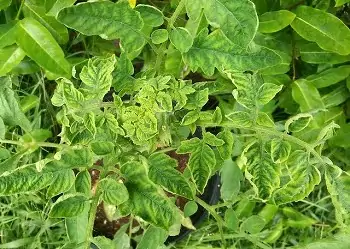
Causes and symptoms:
Physical causes:
Sometimes environmental effects can push to make it happen with plants. When the season jumps from spring to summer, it may occur for overheating or drought.
Besides, rainy weather condition, including extremely cool temperature, also helps to make it happen.
Transplanting of seedlings, over-pruning, lack of water supply, or root damage can cause leaves to roll.
Herbicide effects:
Using herbicides or over-spraying in your garden can cause leaf curling. Stems turning white and leaves turning puckered due to herbicide effects. Sometimes fruit may deform, and plants can’t survive due to overexposure to herbicides.
Viral effects:
Tomato leaf rolling is sometimes caused by a virus called tomato yellow leaf curl virus (TYLCV) which is transmitted through white flies. In the beginning, the leaves roll upwards, then the color of the leaves turns yellow, and the leaves become crumbly. It hampers new blooming and regular plant growth, which significantly reduces fruit production.
Sometimes tomato mosaic virus causes tomato leaves to roll.
Treatments and controls:
Disease-resistant code: “TYLCV”
- Tomato leaves rolling for physical causes doesn’t change the quantity or quality of the fruit production, and you don’t have to take any steps to recover the problem. Leaf curl will be recovered in a few days; you just need to supply water for the plants regularly.
- To reduce herbicide exposure, use a separate sprayer for your tomato plants and lawn. Avoid mulching around tomato plants using grass clippings and watering your plants regularly to recover minor herbicide exposure.
- There was no effective solution for a viral attack of leaves rolling. The best way to protect the virus transmitter (white flies) is through biological control using garden-friendly bugs such as big-eyed bugs, lacewing larvae, and lady beetle larvae.
- Transplant disease-free seedlings for tomato production. Regularly check your tomato plants and if you get any symptoms of a viral attack, immediately remove and destroy the infected plants.

04: Tomato spotted wilt virus
Tomato spotted wilt disease is a virus-transmitted disease caused by the TSWV virus and spread out through insects named Thrips. This is a devastating disease that economically affects around 35 plant families and is a major threat to tomato growers.
This virus performs better in warm conditions, temperate zones, and subtropical and tropical regions around the world. Besides, this can also attack greenhouse conditions.
There has no remedy for this virus, but you can take some precautions as preventative to reduce the risk.
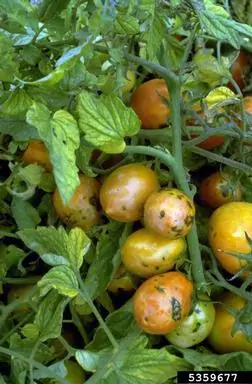
Causes and symptoms:
Spotted wilt spread out by small insect Thrips which survive by sucking tomato or other plants content. At the larval stage, it contains the TSWV virus, then grows to be adult to transmit the disease from infected plants to healthy plants.
Symptoms included bronze, purplish or dark-spotted leaves and brownish or yellow color ring spot on fruits are very common to recognize the virus.
Treatments and controls:
Disease-resistant code: “TSWV”
- Disease-resistant tomato varieties are recommended to avoid this problem if your planting zone is infested by this virus.
- Immediately remove and destroy the infected plants if you recognize the symptoms earlier. It will help you to prevent the spreading of the disease.
- Weed control is another way to control the tomato-spotted wilt virus. Always keep your garden free from weeds and other garden debris.
- Some beneficial garden insects, such as Minute pirate bugs and Big-eyed bugs, can be used as predators to control Thrips.
- Virus-transmitted diseases have no effective treatment, so prevention is the best way to protect against the threat.
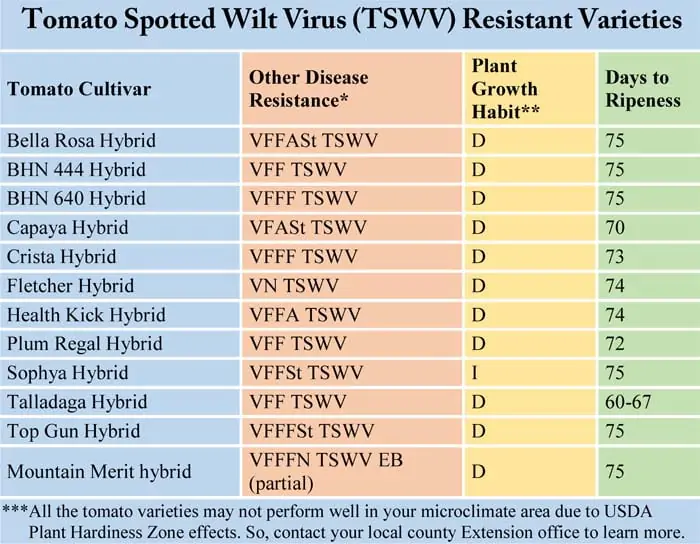
05: Fusarium wilt
Fusarium wilt of tomato is a fungal disease caused by Fusarium Oxysporum. This is a soil-borne disease that develops in warm conditions and sandy or acidic soil throughout the United States. They enter the plants using roots and restrict water circulation in plants, and the leaves become wilt and turn yellow.
Besides tomatoes, they can also attack potato, eggplant, and pepper plants.
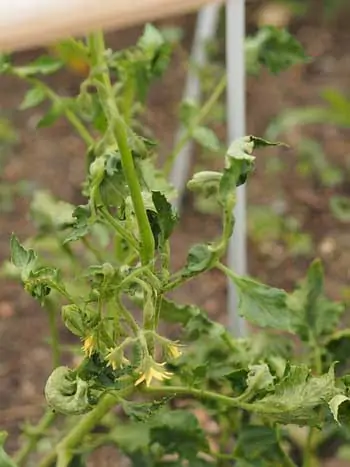
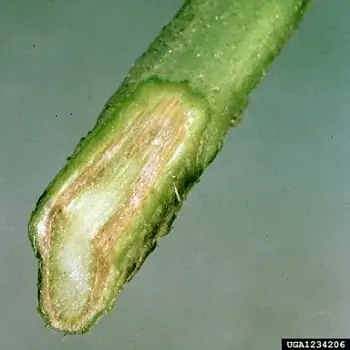
Image Source: Clemson University – USDA Cooperative Extension Slide Series, Bugwood.org
Causes and symptoms:
Fusarium wilt often attacks when the fruits begin mature, and you can see leaves turn yellow from the bottom of the plant. Most of the time, they affect one side of the plant or leaves or branches.
This fungal disease hampers the plants’ growth and
The disease spreads out easily when the temperature reaches 80°-90° Fahrenheit. Besides, imbalanced soil nutrients such as high nitrogen and low potassium are also responsible for the outbreak of Fusarium wilt disease.
Treatments and controls:
Disease-resistant code: “F” or “FF” or “FFF”
- This fungus can survive in the soil or plant debris for up to 10 years, so find some disease-resistant tomato varieties in your area. Crop rotation is another way to prevent the disease.
- Avoid planting Solanaceous plants (such as tomatoes, potatoes, pepper, or eggplant) for at least five years in your garden if your garden is infected by the disease.
- Remove and destroy affected tomato plants in your garden.
- Weed control is another way to prevent the disease.
- Create a proper drainage system and avoid working in wet soil. The disease can transfer by your shoes. You can also use a container using new soil to protect against the disease.
- Test your garden soil to measure the soil nutrient and proper distribution of fertilizer. Use well-balanced or organic fertilizer to reduce the risk of the disease.
- Sanitize your garden tools regularly to prevent the disease.
- There has no treatment for the disease. So, the above precaution is essential to protect Fusarium wilt.
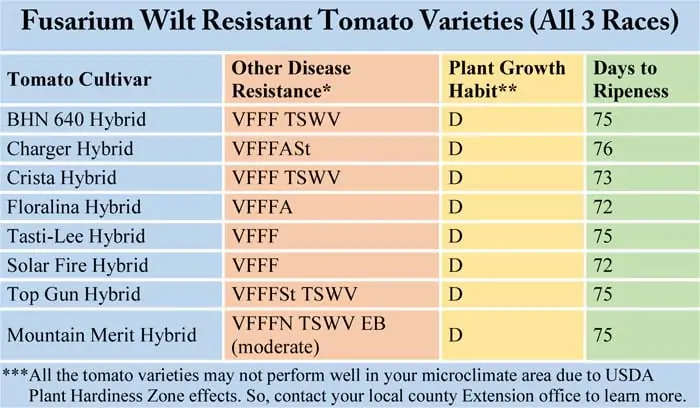
06: Verticillium Wilt
Verticillium Wilt of tomato is a soil-borne fungus caused by the pathogen Verticillium Albo-atrium. It is commonly found in cooler soil of the northern region of the United States.
It can affect more than 200 plant species, especially nightshade family plants, including tomatoes, eggplants, peppers, potatoes, and other host plants.
Causes and symptoms:
Older leaves near the soil turn yellow and curl upwards during the daytime and reopen at night. Slowly the leaves turn brown from yellow and finally drop off.
The pathogen mostly attacks the older and lower-level leaves, and only the upper leaves remain green. Sunscald appears on tomato fruits due to drop-off as well as the removal of infected foliage.
Fruit size becomes smaller due to the attack of the disease, and the symptom mostly noticeable when the plants start producing fruits. Fruits start dropping off from the infected stems before they are ripe.
The fungus spreads out when soil temperature remains between 60°-75° Fahrenheit with the presence of high moisture. Poor drainage system helps to flourish the fungus more quickly.
Treatments and controls:
Disease-resistant code: “V”
- There is no chemical treatment, so choose verticillium fungus-resistant tomato varieties.
- Well-drained soil keeps the balance of the soil moisture and reduces the risk of infection.
- Dispose of the infected plants by burning them after the season end.
- Avoid planting tomatoes and other Solanaceous crops in your garden area for four years to remove the fungus if exist.
- Sanitize your garden tools after work, and don’t move in the garden when the soil is wet.
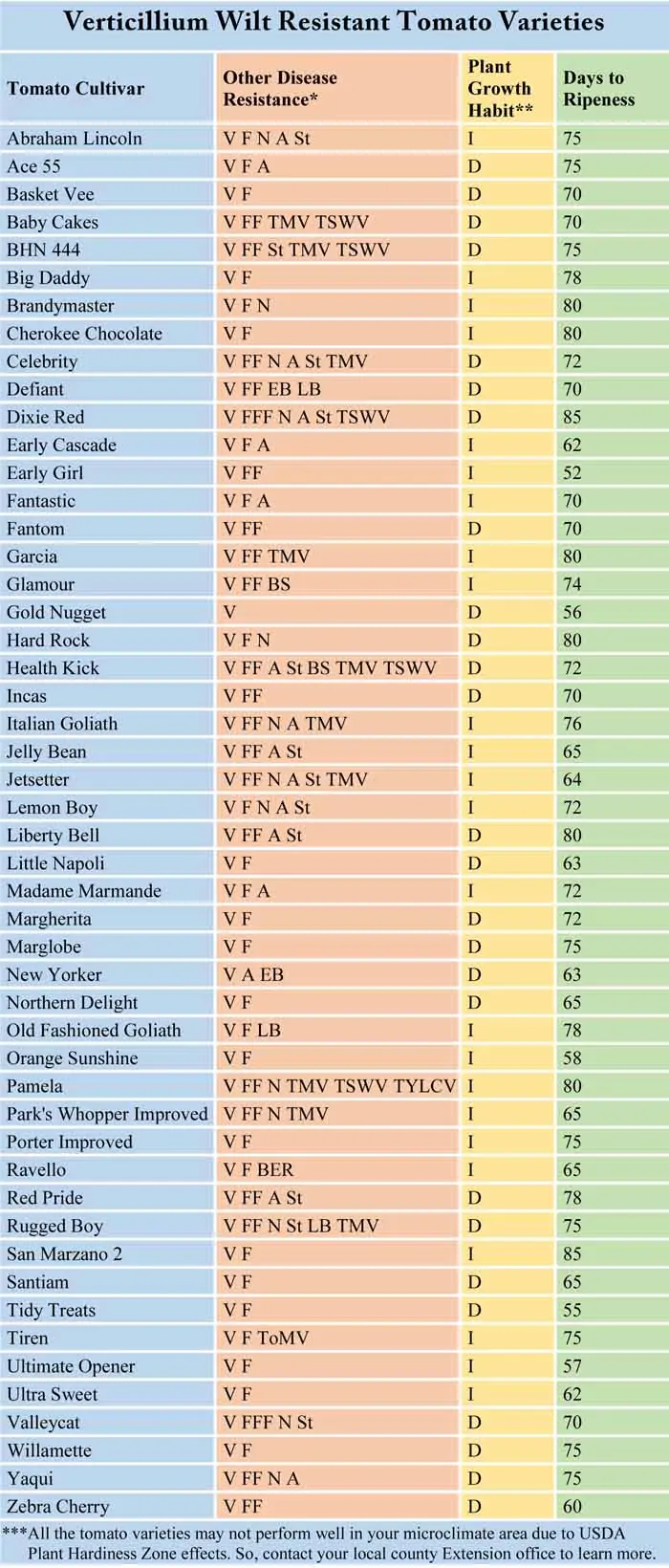
07: Tomato Bacterial Wilt
Bacterial wilt of tomato, often called southern bacterial wilt, is a serious soil-borne disease caused by the pathogen bacterium Ralstonia Solanacearum. The bacterium exists in the soil and thrives in highly warm and humid weather conditions.
It attacks more than 200 plant species all over the world, including susceptible host plants like tomato, eggplant, pepper, and potato.
Causes and symptoms:
Symptoms first appear on the youngest leaves during the hottest time of the day.
Plants start to be wilted in the daytime and recover at night.
Acidic soil, infertile soil, and heavy clay soil encourage thriving diseases.
Wet and humid weather condition after heavy rainfall when the temperature goes above 85°F helps to thrive the disease.
The disease can spread out through running water and infected soil mixing with uninfected soil.
Plants become wilted when the disease develops, and it can attack at any stage of the growing period, especially the plants set fruit.
The bacterium also hampers plant growth.
The whole plant becomes wilted quickly when the symptom appears, and finally, the leaves turn yellow before the death of the plants.
Pruning plant stems, insect attacks on plants, or any type of injury over the tomato plants can cause bacterial wilt. High pH in the soil can also invite the pathogen.
Clearly identify the bacterial wilt attack; just cut off a finger-length main stem from an infected tomato plant and sink it in a glass of water for a few minutes, and you can see milky white bacteria will appear on the stem.
Treatments and controls:
Disease-resistant code: “BW”
- No chemical control available for the bacterial wilt, so chooses resistant varieties.
- If your plants are once infected by the bacterial wilt, rotate your crop cycle for four years and avoid planting tomato, eggplant, pepper, potato, and other susceptible host plants.
- Maintain proper drainage system with required soil pH around 6 to 7 in scale.
- Pay more attention when working in the garden and try to minimize root damage and plant injuries.
- Burn the infected plants as soon as found, and remove the surrounding soil of the infected plants from your garden.
- Use raised bed and container if your garden area is infested by the disease.
- Always wash your plants properly after working in the garden.
- Remove and burn your garden debris after finishing each season.
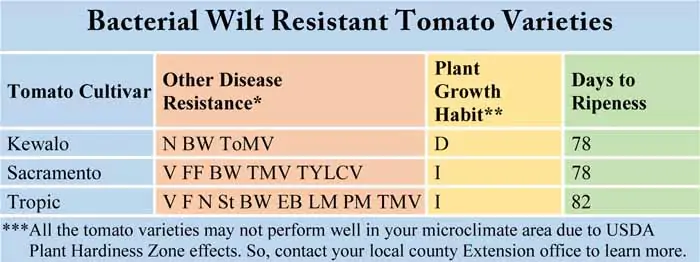
08: Tomato Powdery Mildew
Powdery mildew of tomato is a common fungal disease caused by the pathogen Leveillula Taurica. This is mainly a warm and dry climate disease.
Powdery mildew is a foliar disease that doesn’t attack the fruits and stems of tomato plants.
It has a narrow area of host plants like nightshade family plants and mostly infects the home garden rather than a commercial garden.
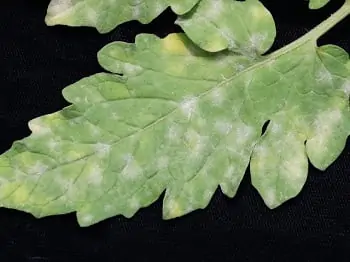
Causes and symptoms:
Pale yellowish spots appear on the foliar at the beginning stage. Soon the spots were covered with flour-type mildew. As the disease develops, the spots turn brown and shrivel.
It is more susceptible in late summer.
Old and stressed plants are mostly affected by the disease.
Plants become weak due to foliar damage and insufficient energy sources, which resulting the drop off of leaves.
Plants’ growth is stunted and fruits from infected plants become less flavorful.
Treatments and controls:
Disease-resistant code: “PM”
- Provide adequate soil nutrients and air circulation around the plants.
- Pick out the infected leaves and harvest tomatoes from the infected plants as soon as you notice.
- Remove and bury the infected plans to prevent the disease from spreading out to the next season.
- Apply sulfur fungicide to protect your tomato plants before establishing powdery mildew. Or use neem oil, horticultural oil, jojoba oil, and biological fungicide to destroy the infection after its appearance.
- You can also use milk solution spray to control powdery mildew; take 1 part of milk diluted in 10 parts of water and maintain a scheduled spray every 10 days interval after the symptom appearance.

09: Tomato Leaf Mold
Leaf mold of tomato is a fungal disease caused by the pathogen Passalora Fulva, which mostly infects the tomato foliage.
The pathogen thrives in humid weather conditions, especially common in greenhouses and high tunnels.
This fungus has no hosts and only infects tomato plants.
Causes and symptoms:
The oldest leaves are primarily infected and appear pale greenish to yellow spots without definite borderline on the upper leaf surface. The infected leaves may seem yellow due to a lack of nutrients.
On the other hand, the lower leaf surface
Before long, the leaf spots grow together, turning brown and withering, and finally, die before they mature and sticking to the plant.
The pathogen attacks the plants when the humidity level goes above 85%.
The fungi can perform better at a temperature between 71°F to 75°F, but they can also be susceptible at a temperature from 40°F to 90°F range.
Symptoms sometimes also appear on blossoms, stems, and fruits. Blossoms drop off; fruits develop dark, sunken, and leathery spots on the stem end and finally rot it.
Treatments and controls:
Disease-resistant code: “LM”
- When the symptoms appear in greenhouse conditions, use vents and fans to provide air circulation to reduce the humidity level in the infected areas.
- In an open field, planting with enough spacing between plants up to 3 feet depending on the tomato variety, to access air circulation. Maintain a parallel line for planting tomato plants and use staking if needed.
- Avoid watering over the plant leaves to spread out the disease from one plant to another. You better use a drip irrigation system.
- This is a seed-borne disease, so collect some resistant varieties from reputed sources.
- The pathogen can survive in the soil for one year, so never plant on the same ground the next year, rather, change the field location.
- Remove and burn the crop residue and plant debris to avoid the pathogen spreading out.
- Apply calcium chloride spray as chemical treatment and spray both sides of the infected leaves.
- You can also apply milk spray, garlic spray, apple cider, and vinegar mix
to treat and control the outbreak of the pathogen.
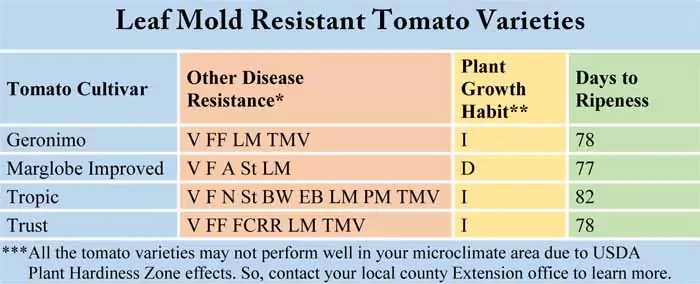
10: Other Leaf Diseases
There have some several tomato leaf diseases which also affect tomato stems and fruits Such as:
- Bacterial Speck (Leaf+Stem+Fruit)
- Bacterial spot (Leaf+Stem+Fruit)
- Bacterial Canker (Leaf+Stem+Fruit)
- Early Blight (Leaf+Stem+Fruit)
- Late Blight (Leaf+Stem+Fruit)
- Mosaic Virus (Leaf+Fruit)
- Sunscald (Fruit+Leaf)
To learn more of the following diseases read the common tomato fruit problems.
How to read tomato codes
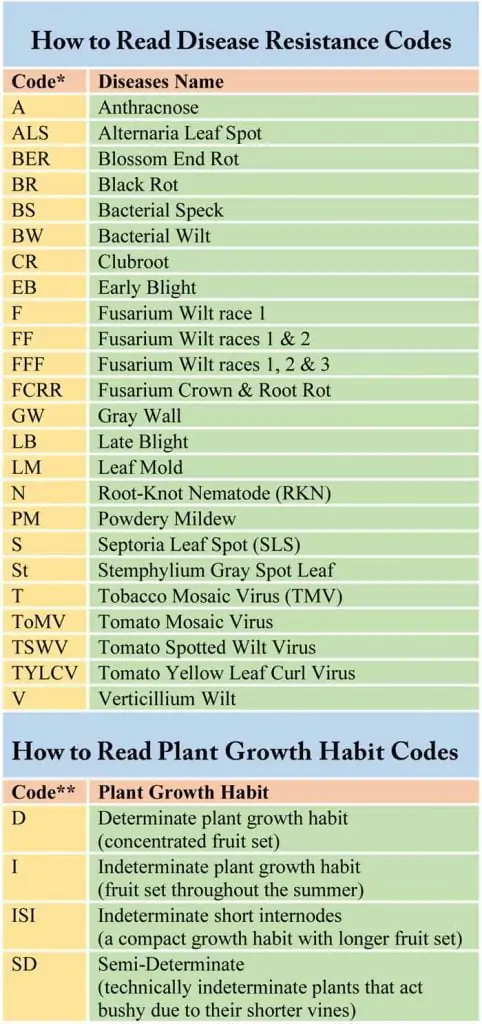
Conclusion:
Proper tomato care (including right seed selection, mulching, shading, pruning, watering and fertilizing) can reduce the risk into half of all the tomato leaf and other plant problems. But, some of the problems created due to environmental effects which you can’t control.
Some diseases resistant varieties may found locally also help to solve the possible tomato leaf problems according to your geographic location. To learn more details about foliar diseases and problems you should contact your local extension office.
Read More:
*** 7 Basic Reasons Behind Common Tomato Plant Problems
*** 5 Common Tomato Stem Problems and Solutions
Sources and Citations:
- https://extension.sdstate.edu/tomato-spotted-wilt-virus
- http://vegetablemdonline.ppath.cornell.edu/factsheets/Tomato_Septoria.htm
- https://hgic.clemson.edu/factsheet/tomato-leaves-rolling/
- https://homeguides.sfgate.com/remedies-leaf-curl-tomato-plants-39900.html
- https://www.clemson.edu/public/regulatory/plant-problem/fact-sheets/tswv.html
- https://tomatodiseasehelp.com/spotted-wilt-virus
- http://www.tomatodirt.com/gray-leaf-spot.html
- https://extension.umn.edu/diseases/fusarium-wilt
- https://www.growveg.com/plant-diseases/us-and-canada/tomato-powdery-mildew/

